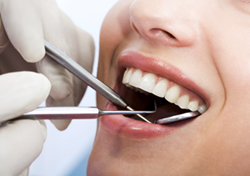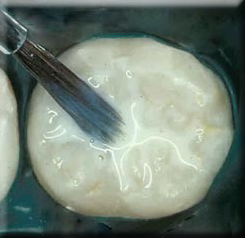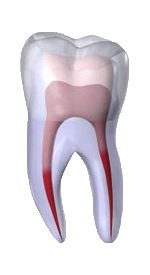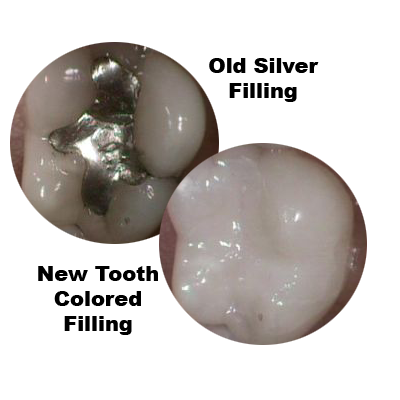General Dentistry
In essence, general dentistry encompasses a wide array of dental procedures designed to keep your gums and teeth healthy, which then translates into better overall health. Robert F. Cannis, DMD, offers a variety of general dentistry services for the entire family, including preventive, restorative, endodontic, periodontal, and exodontia therapies, such as:
- Exams
- Cleanings
- Dental Sealants
- Root Canal Therapy
- Tooth-Colored White Fillings
- Procera Crowns
- Bonding
- TMJ/TMD Treatment
- Sleep Apnea and Snoring Treatments
We strive to promote long-term oral health by providing education on good oral hygiene, the importance of regular checkups, and by developing a personalized plan to improve and maintain your dental health. In this way, we’re able to diagnose and treat small problems before they develop into more serious issues.
Our priority at Robert F. Cannis, DMD, is the overall good health of you and your family. Call us today to set up an appointment.
The Healthy Smile, Healthy Body Connection
 Regular dental visits are important in maintaining and improving your oral health, but did you know that these visits may also assist in the identification and prevention of certain types of disease? For example, research has indicated a possible relationship between gum disease and cavities with health conditions such as diabetes, stroke, and respiratory disease.
Regular dental visits are important in maintaining and improving your oral health, but did you know that these visits may also assist in the identification and prevention of certain types of disease? For example, research has indicated a possible relationship between gum disease and cavities with health conditions such as diabetes, stroke, and respiratory disease.
In addition, poor oral health can lead to other health issues, including digestion problems, oral and facial pain, and even increased risk for developing cardiovascular disease. And since many people see their dentist more frequently than they do their personal physician, the first diagnosis of a health problem often occurs at the dental office.
Yes, there is a strong connection between having a healthy smile and a healthy body. Here, at Robert F. Cannis, DMD, we believe in this connection, and we use it day-in and day-out to deliver the best possible care to our patients.
Preventive Dentistry and Cleanings
 The primary goal of preventive dentistry is to maintain optimal oral health. Daily home-care practices, such as brushing and flossing, combined with periodic in-office preventive care, like standard and deep cleanings, are vital components in keeping your teeth and gums as healthy as possible. Brushing and flossing alone, however, will not remove tartar (a form of hardened dental plaque), which is why professional dental cleanings are so crucial.
The primary goal of preventive dentistry is to maintain optimal oral health. Daily home-care practices, such as brushing and flossing, combined with periodic in-office preventive care, like standard and deep cleanings, are vital components in keeping your teeth and gums as healthy as possible. Brushing and flossing alone, however, will not remove tartar (a form of hardened dental plaque), which is why professional dental cleanings are so crucial.
When plaque and tartar remain on teeth for too long, the risk of developing gingivitis is high. Left untreated, gingivitis will advance to the more serious periodontits, a disease that will eventually damage the bones, gums, and tissue that support the teeth. In order to preserve your dental health, preventive care that includes regular dental examinations is necessary.
Secondary to health, but also important, maintaining good oral hygiene along with periodic in-office visits will help reduce money spent on dental treatments later.
Dental Sealants – Protection from Decay
 As important as brushing and flossing is, there are additional measures that can be used to help protect your teeth from decay. Dental sealants—thin, plastic coatings that are painted on the chewing surfaces of teeth—are one such measure. By applying sealants to the grooves and depressions in your back teeth, you can effectively “seal out” decay-causing bacteria.
As important as brushing and flossing is, there are additional measures that can be used to help protect your teeth from decay. Dental sealants—thin, plastic coatings that are painted on the chewing surfaces of teeth—are one such measure. By applying sealants to the grooves and depressions in your back teeth, you can effectively “seal out” decay-causing bacteria.
The procedure is fast, simple, painless, and safe. Painted on in liquid form, dental sealants dry quickly and harden to form a thin, protective, non-invasive shield over the tooth. And because dental sealants can last for up to 10 years, they are a proactive, cost-effective measure in maintaining your good oral health.
Root Canal Therapy
 When the nerve of a tooth is affected by decay or infection, root canal therapy is used to save the tooth. By and large, people wince when they hear the term “root canal,” but root canal therapy is a safe, effective, and low-pain option for saving teeth that would otherwise have to be extracted. And, in fact, is the preferred treatment.
When the nerve of a tooth is affected by decay or infection, root canal therapy is used to save the tooth. By and large, people wince when they hear the term “root canal,” but root canal therapy is a safe, effective, and low-pain option for saving teeth that would otherwise have to be extracted. And, in fact, is the preferred treatment.
Why is this when a tooth extraction seems so much simpler? Tooth extractions tend to cause problems for the adjacent teeth and, when dental implants and bridges are taken into consideration, are ultimately more expensive. Root canal therapy isn’t a scary procedure, and most patients experience little-to-no pain.
The process consists of numbing the area around the affected tooth, removing the pulp (living tissue inside the tooth), nerves, bacteria, and any existing decay that is present. In order to restore the tooth to its full function, the resulting space is then filled with special medicated dental materials. While some soreness may be present following the procedure, over-the-counter painkillers are typically enough to remedy the discomfort.
Root canal therapy is a highly successful, routine treatment. If you are experiencing pain, contact Robert F. Cannis, DMD, to set up a consultation.
Tooth Colored White Fillings
 Tooth colored fillings are dental fillings used to restore teeth that are fractured or decayed. Made from durable plastics called composite resins, tooth colored fillings closely match your natural tooth’s color, appearance, and texture. In addition, they can cosmetically alter the size and shape of teeth by closing gaps, repairing chips, and giving the appearance of straighter teeth.
Tooth colored fillings are dental fillings used to restore teeth that are fractured or decayed. Made from durable plastics called composite resins, tooth colored fillings closely match your natural tooth’s color, appearance, and texture. In addition, they can cosmetically alter the size and shape of teeth by closing gaps, repairing chips, and giving the appearance of straighter teeth.
The benefits of tooth colored fillings extend beyond the cosmetic advantages, though. They are strong, harden quickly, don’t expand/contract in extreme hot and cold temperatures, and create a better seal over your teeth than traditional, silver/amalgam fillings.
Whether you’re in need of new fillings or are considering replacing your traditional fillings, tooth colored fillings are an ideal solution.
All-Porcelain Crowns & Bridges
 For years, traditional silver dental crowns were the only choice available in replacing an irreparably damaged or injured dental crown. These crowns and bridges functioned well, but couldn’t be described as cosmetically appealing. When tooth colored restorations were initially made available, they looked terrific but weren’t as reliable or strong as their metal counterparts.
For years, traditional silver dental crowns were the only choice available in replacing an irreparably damaged or injured dental crown. These crowns and bridges functioned well, but couldn’t be described as cosmetically appealing. When tooth colored restorations were initially made available, they looked terrific but weren’t as reliable or strong as their metal counterparts.
Now, with all-pocelain crowns and bridges, dental patients no longer have to choose between having a reliable dental crown or bridge and having one that looks good. All-porcelain crowns contain no metal, are cosmetically beautiful, and fit better than its metal predecessors. They are reliable and strong. Best of all, they have the same color and translucency of your natural teeth.
A few of the other benefits of all-porcelain crowns and bridges include:
- Low risk of allergic reactions
- Zero metallic taste
- Zero sensitivity to temperature
With Procera® Crowns, you’ll smile with confidence while feeling secure.
Dental Bonding
 One method for improving the appearance of your teeth is a technique called dental bonding. This process involves adhering tooth colored material to your teeth to correct and restore a variety of dental issues, including:
One method for improving the appearance of your teeth is a technique called dental bonding. This process involves adhering tooth colored material to your teeth to correct and restore a variety of dental issues, including:
- Chipped and cracked teeth
- Discolored teeth
- Teeth with gaps or spaces
- Uneven, out-of-proportion, or irregularly shaped teeth
Dental bonding is an easy, lower-cost alternative to other general and cosmetic dental procedures that can often be completed in one office visit.
TMJ/TMD Treatment
 TMJ disorder (TMD) is a chronic degenerative disease, and is generally defined as an imbalance between the jaw and skull with the muscles that control jaw movement. This imbalance can cause consistent muscle fatigue, headaches, migraines, facial pain, ear pain, jaw pain, ringing in the ears, difficulty chewing, uncomfortable bite, worn-down teeth, as well as additional areas of lingering discomfort and pain.
TMJ disorder (TMD) is a chronic degenerative disease, and is generally defined as an imbalance between the jaw and skull with the muscles that control jaw movement. This imbalance can cause consistent muscle fatigue, headaches, migraines, facial pain, ear pain, jaw pain, ringing in the ears, difficulty chewing, uncomfortable bite, worn-down teeth, as well as additional areas of lingering discomfort and pain.
If any of the above sounds like a problem you are experiencing, the first step to relief is diagnosis. Upon arriving at our office for a consultation, Dr. Robert F. Cannis will complete a thorough evaluation to determine if you are suffering from TMJ disorder. Once a positive diagnosis is made, he and his team will develop a customized treatment plan designed to alleviate your symptoms.
We have been able to help many patients suffering from TMJ disorder find relief. Let us help you.
Sleep Apnea/Snoring Treatment
 Snoring occurs when air is unable to move freely through your nose and mouth during sleep, often caused by a narrowing of the airway, usually from abnormalities of the soft tissues in the throat, but the position of your tongue and poor sleep posture are also contributing factors. What many people don’t realize is that in addition to poor sleep, fatigue, and irritability, snoring can lead to increased health problems.
Snoring occurs when air is unable to move freely through your nose and mouth during sleep, often caused by a narrowing of the airway, usually from abnormalities of the soft tissues in the throat, but the position of your tongue and poor sleep posture are also contributing factors. What many people don’t realize is that in addition to poor sleep, fatigue, and irritability, snoring can lead to increased health problems.
Your body requires sleep in order to remain healthy, and snoring isn’t the only culprit that can interfere with a restful night. We all have moments in our lives that have been filled with one sleepless night after another, but many people think they’re sleeping all night only to wake in the morning feeling exhausted. How can this be?
One possible explanation is a common, potentially dangerous disorder called sleep apnea. A person suffering from sleep apnea will have one or more pauses in their breathing while they sleep. These pauses can last upward of several minutes before normal breathing resumes, often occurring repeatedly per hour, pulling the person in and out of deep sleep with each pause.
While sleep apnea can only be diagnosed by a physician, there are some warning signs:
- Snoring
- Restless sleep
- Waking up often at night
- Insomnia
- Waking with a sore and/or dry throat
- Waking up with a choking or gasping sensation
- Sleepiness while driving
- Morning headaches
- Daytime sleepiness/lethargy
- Forgetfulness
- Mood changes
If you think you might have sleep apnea, it is important to contact your medical doctor for a diagnosis. Once you have the diagnosis, or if you are already aware that you suffer from sleep apnea, there are several possible treatment plans to consider.
Weight loss, exercise, and good sleep hygiene are proactive steps you can begin immediately; however, since sleep apnea can pose a serious danger to your health, you shouldn’t stop there. Surgery is an option for some people. Another treatment is use of a pressurized air generated delivery system, called a CPAP (Continuous Positive Airway Pressure), while you sleep.
At Robert F. Cannis, DMD, we offer Oral Appliance Therapy to patients suffering from sleep apnea and/or snoring. These oral appliances, similar to orthodontic retainers, are custom designed and fitted to you. Worn during sleep, the appliance attempts to maintain an open, unobstructed airway so the pausing in your breathing abates, allowing you to get the healthy, restful sleep you’ve been missing.
There are treatment options for people suffering from sleep apnea and snoring. We would love to help you get a good night’s sleep. Contact us for more information.
Service Areas: Toms River/Jackson/Lakewood/Manchester/Brick/Howell
Ocean County/Monmouth County/Toms River Township










